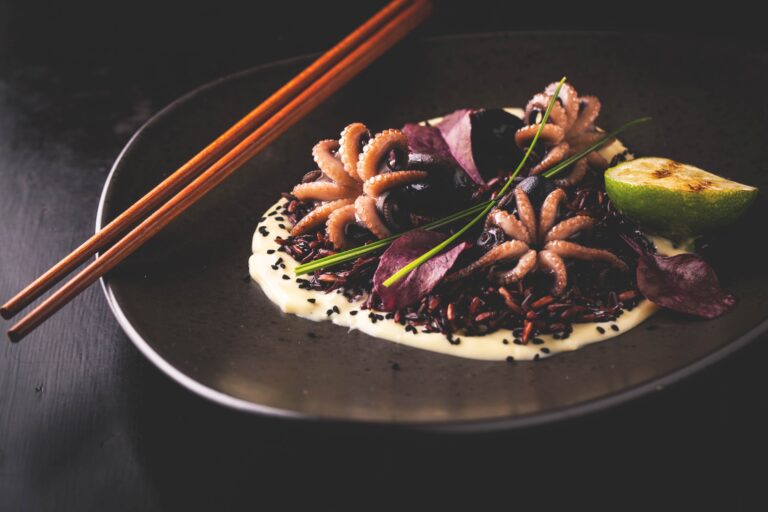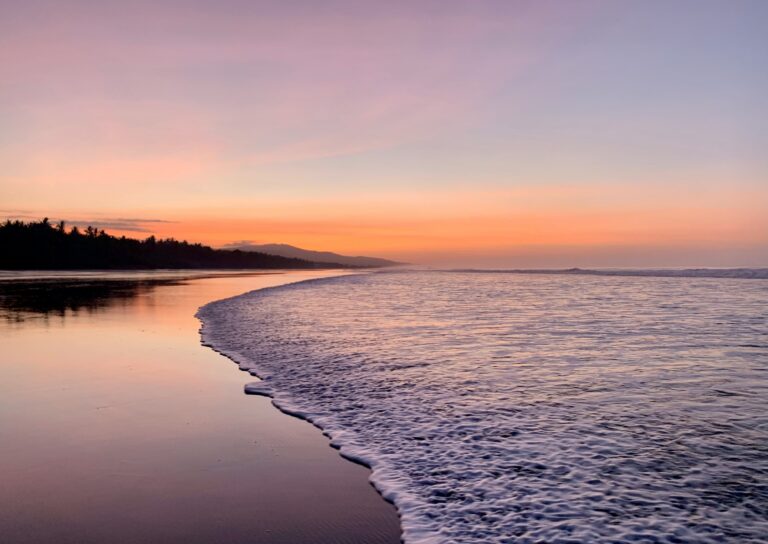The island of Bali, Indonesia, might be small, but its geography is anything but simple. From towering volcanic peaks and black sand beaches to lush rice terraces and sacred lakes, this tropical paradise is packed with natural variety.
Understanding Bali’s geography helps you get the most out of your trip, whether you’re chasing waves, waterfalls, or sunrise hikes.
First, a little bit about the wider region:
Indonesian Archipelago
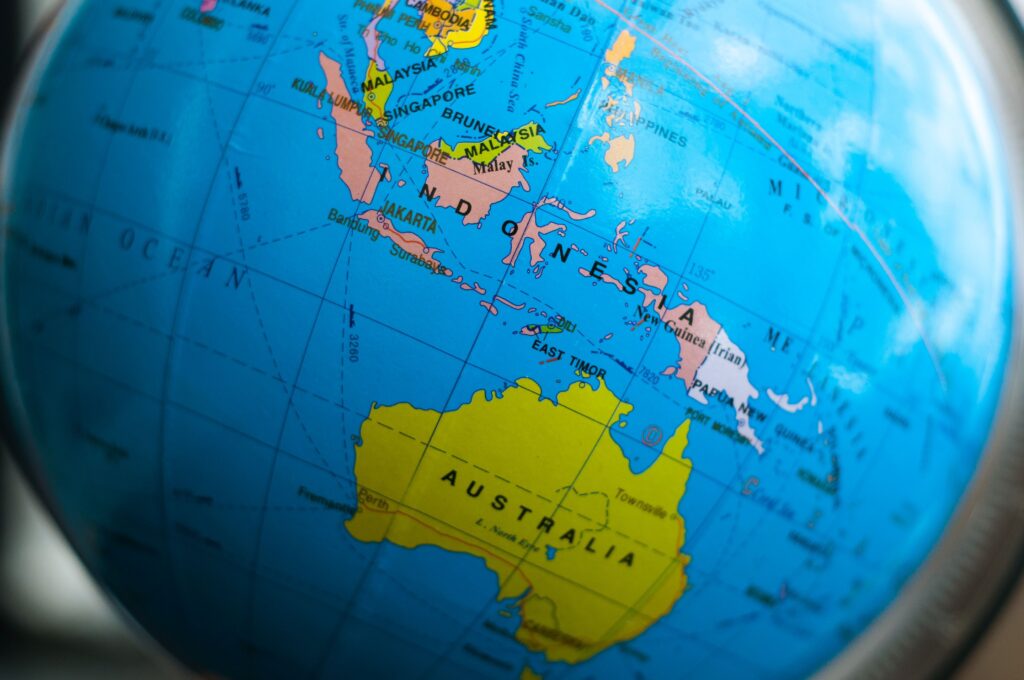
Bali is one of over 17,000 islands that make up the Indonesian Archipelago, the world’s largest island chain, stretching across Southeast Asia between the Pacific and Indian Oceans.
This region encompasses a diverse range of marine and terrestrial environments, shaped by tectonic activity and volcanic forces.
Bali lies just south of the equator and shares many geological and climatic traits with its neighbouring islands. Its location in this vast archipelago places it within a major zone of biodiversity and seismic activity.
Lesser Sunda Islands
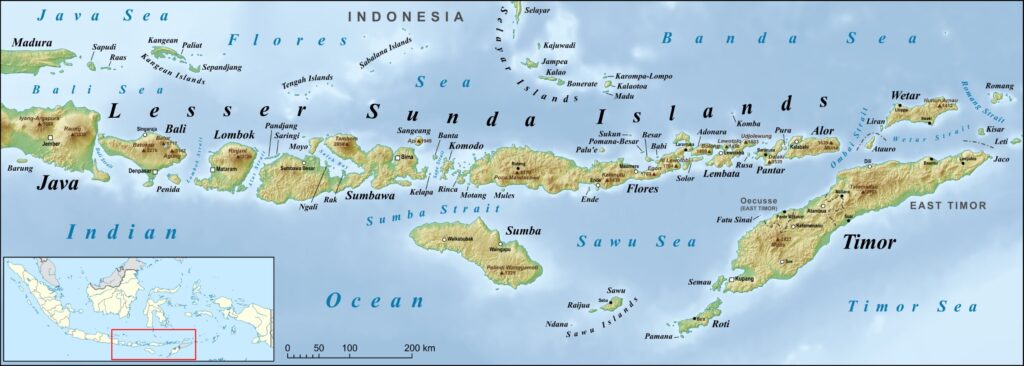
Bali is located just a few kilometres across the Bali Strait from Java, and is the first of the Lesser Sunda Islands, a group of Indonesian Islands which stretch eastwards and include Lombok, Sumbawa, and Flores.
These islands sit along the Wallace Line, a boundary separating Asian and Australasian species. The region’s deep straits and volcanic peaks define its rugged terrain and fertile soils.
Bali Island

Bali Island blends volcanic peaks, black sand beaches, and white sand coastlines. The east coast shows off the island’s volcanic activity, while the west coast draws visitors with stunning white sand beaches. This tropical paradise offers rich geography and endless Bali experiences.
Bukit Peninsula
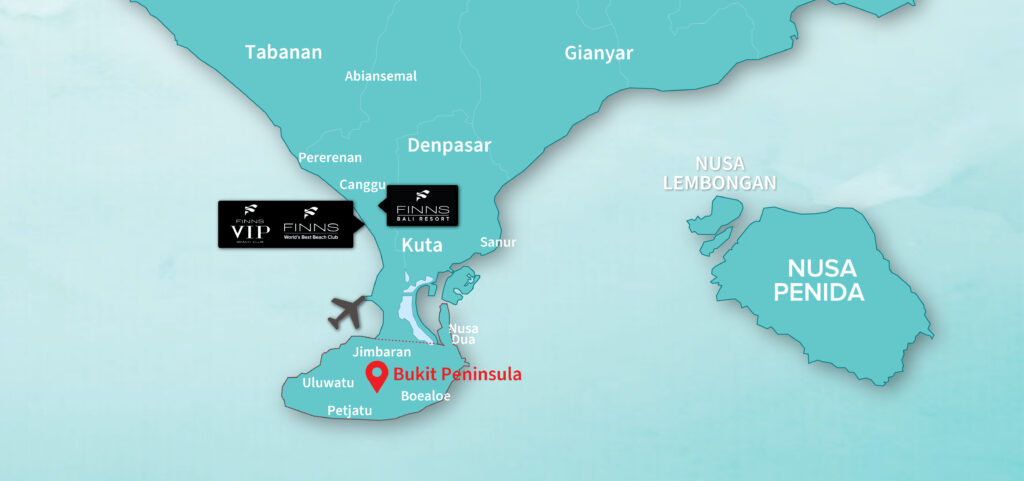
The Bukit Peninsula forms the southern tip of Bali and, at times, feels like a different island entirely. Arid, rocky, and elevated, it’s a land of dramatic cliffs and hidden beaches.
Uluwatu is the star down here, famous for its pumping surf, cliff-hanging temple, and laid-back vibe. The Indian Ocean slams into limestone walls below, while white sand beaches wait in sheltered coves. Surfers from around the world come for the breaks; everyone else comes for the sunsets and cliff-top bars.
On the east of the Bukit Peninsula sits Nusa Dua, a favourite holiday spot. The beaches in the south tend to have white sand.
Thanks to its dry climate, the Bukit is perfect during Bali’s rainy season. Think barefoot luxury, ocean views, and breezy evenings above the waves.
East Coast
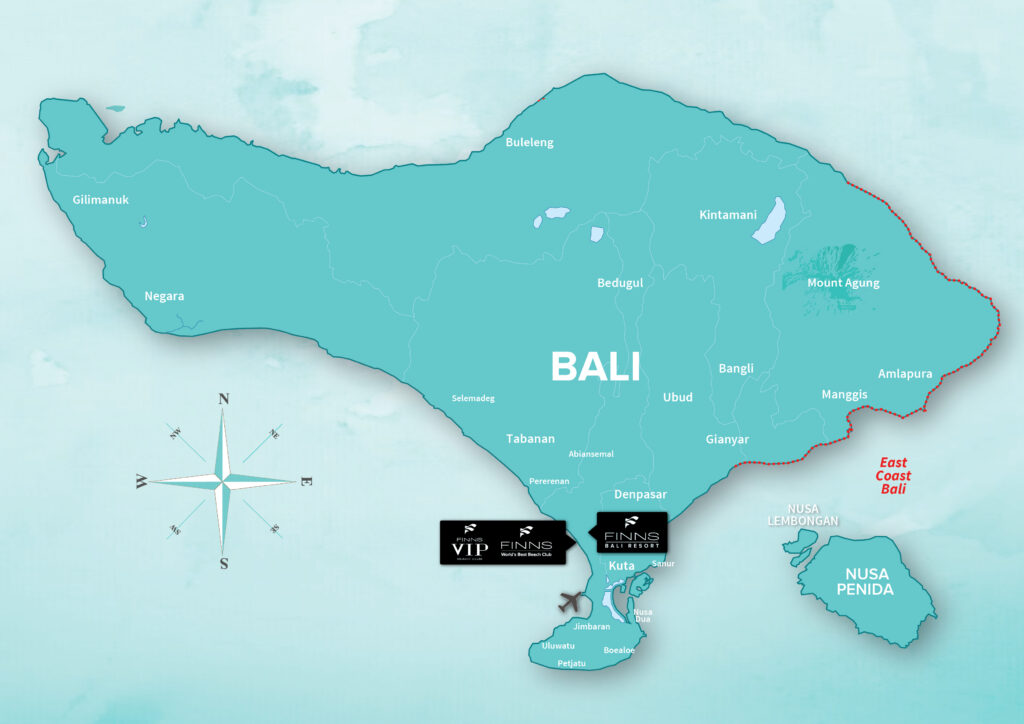
Bali’s east coast is raw, rugged, and rich in tradition. Black sand beaches, formed from volcanic lava, stretch along sleepy fishing villages where locals launch small boats into the Bali Sea at sunrise.
This side of the island lies in the shadow of Mount Agung, Bali’s highest and most sacred peak. It’s less developed than the south, with fewer crowds and more old-world charm. Dive in Amed’s clear waters, explore ancient temples, or simply soak up the slower pace of life.
Here, the volcanic energy is felt both underfoot and in the island’s deep spiritual connection.
West Coast

The west coast of Bali offers a completely different vibe, think stunning white sandy beaches, laid-back surf spots, and plenty of room to breathe.
This is where you’ll find popular spots like Canggu and Seminyak, packed with surfers chasing waves and cliff-top bars serving up sunset cocktails. The surf here is world-famous, making it a magnet for riders of all levels.
Along the shoreline here, large rock formations protrude from the ground, and traditionally, temples were built on them, like the famous Tanah Lot.
One standout on this coast is FINNS Beach Club, the biggest beach club in the world, known for its epic parties, incredible views, and a perfect place to soak up the Bali vibe.
Beyond the beaches, it is home to Bali’s largest city, Denpasar, and the bustling port town of Gilimanuk, gateway to the neighbouring island of Java.
It’s a blend of vibrant nightlife, cultural hubs, and endless rows of rice paddies stretching inland.
Denpasar

Denpasar is the provincial capital city of Bali and the island’s urban heart. It’s home to markets, government offices, and cultural heritage. While not a main tourism spot, it shows daily life and Balinese people beyond the beaches.
Central Highlands
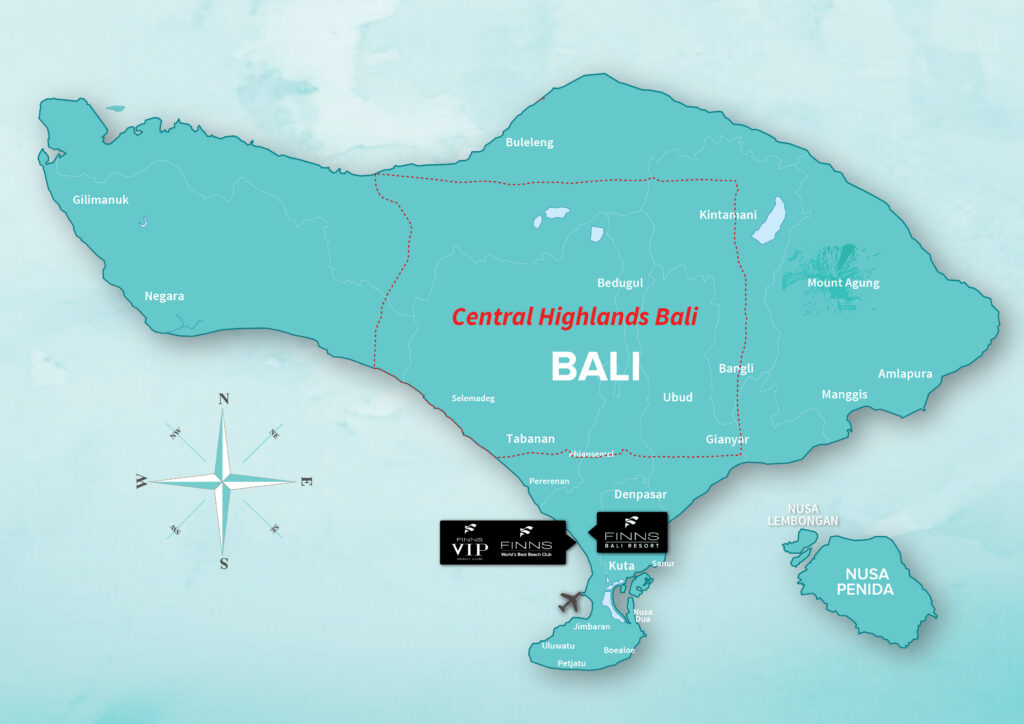
The central mountains of Bali form the island’s green core, home to volcanic peaks like Mount Batukaru. This cooler region features rice terraces, coffee farms, and traditional villages rooted in ancient Bali.
It’s a scenic escape from the coastal crowds.
Lakes
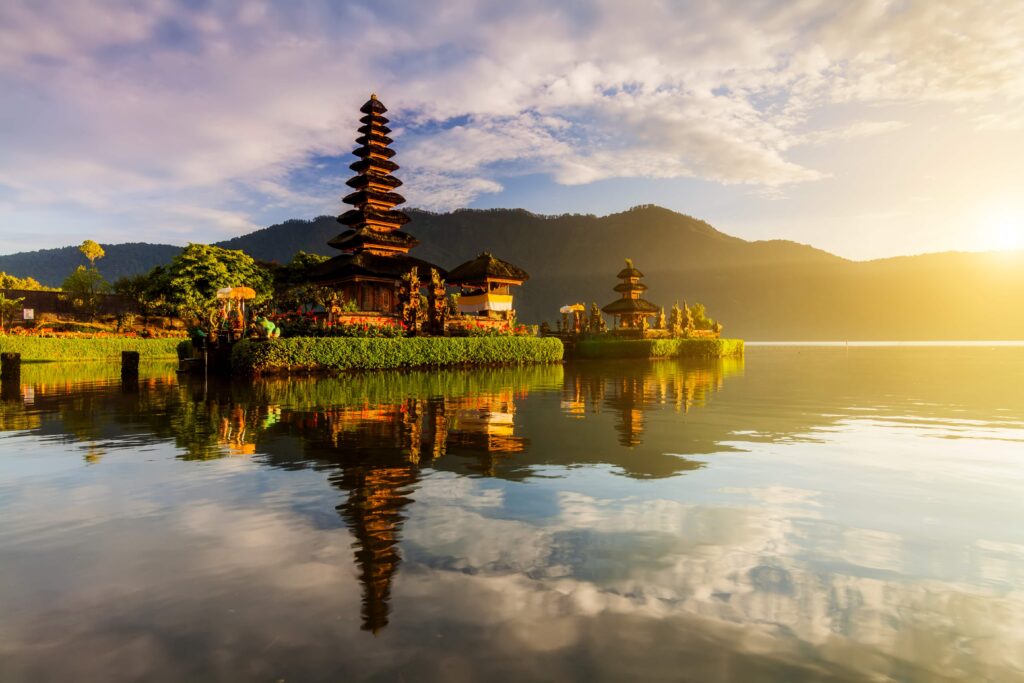
Bali’s Central Highlands feature several sacred lakes known for their natural beauty and cultural importance. Lakes Bratan, Buyan, Tamblingan, and Batur are surrounded by lush forests and rolling hills, providing peaceful escapes from the coast.
Lake Bratan is famous for the Ulun Danu Temple, an iconic sight on the water’s edge. Lake Batur lies near the active Mount Batur volcano and plays a key role in Bali’s water system.
These lakes showcase Bali’s lush landscapes and offer a serene side of the island away from the beaches.
Volcanoes

Bali’s dramatic landscape is shaped by its active volcanoes, especially Mount Agung and Mount Batur. Mount Agung, the island’s highest peak and sacred “mother mountain,” dominates the skyline and holds great spiritual significance.
Mount Batur, a popular hiking spot, offers stunning sunrise views over the Bali Sea and surrounding islands. These volcanic peaks are key to Bali’s beautiful nature and cultural heritage, drawing visitors year-round.
The volcanic nature of Bali has given its land exceptional fertility, which is complemented by a complex irrigation system stemming from the volcanic lakes.
Ubud Region
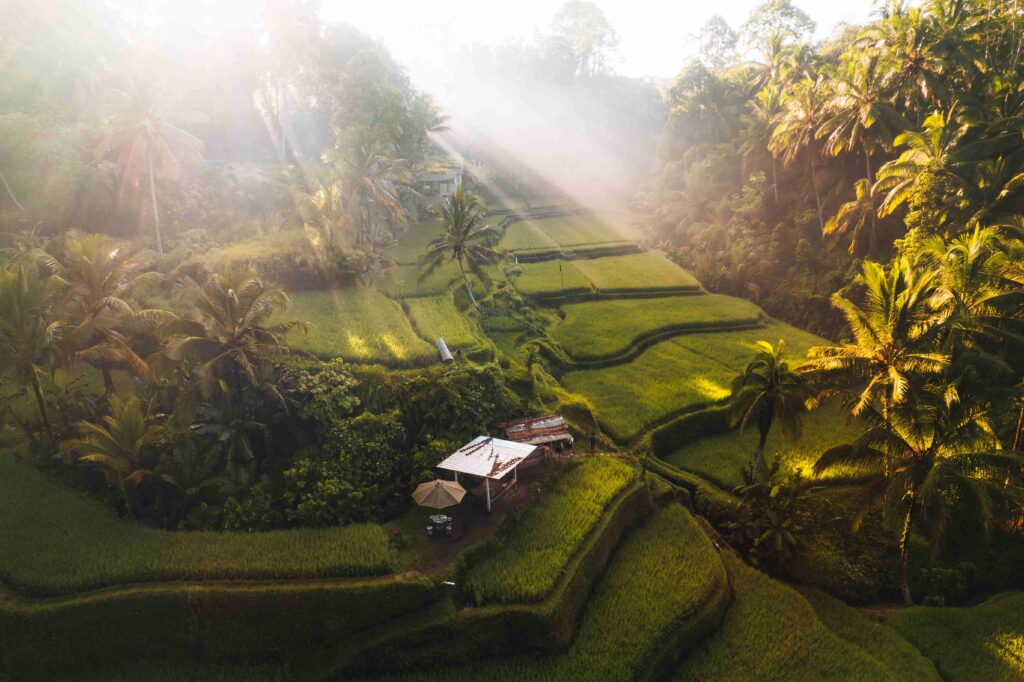
Nestled in a lush valley surrounded by gentle hills, the Ubud region is Bali’s cultural heart. Known for its arts, traditional crafts, and spiritual energy, Ubud offers a different kind of landscape — terraced rice fields, sacred temples, and dense jungle trails.
Unlike the rugged peaks of the Central Highlands, Ubud’s terrain is softer but no less stunning. It’s where Bali’s rich cultural heritage comes alive, making it a must-visit for anyone wanting to experience the island beyond the beaches.
Bali Sea

The Bali Sea hugs the island’s north and east coasts, ranging from shallow reefs to deep waters over 1,000 meters.
It’s home to vibrant marine species like turtles, manta rays, and colourful fish, making it a top spot for scuba diving and snorkelling.
The Bali Sea is key to Bali’s natural beauty and coastal lifestyle.
Across The Water:
There’s a world of exploration just east across the Lombok Strait from the island of Bali.
From the Nusa Islands (which actually form part of Bali), to Lombok Island, to the tiny but amazing Gili Islands.
Nusa Islands

Just a short boat ride from Bali’s southeast coast, Nusa Islands refers to three small islands: Nusa Penida — the largest and from which the group gets its name — and the two smaller islands of Nusa Ceningan and Nusa Lembongan.
This rugged island group is known for dramatic cliffs, crystal-clear waters, and stunning natural landmarks.
Less developed than Bali, it’s packed with jaw-dropping spots like Kelingking Beach, Angel’s Billabong, and Crystal Bay. A magnet for adventure seekers, you can snorkel with manta rays, explore hidden coves, or hike to breathtaking viewpoints.
- Nusa Penida – The largest island, rugged with dramatic cliffs and famous spots like Kelingking Beach. Ideal for hiking and spotting wildlife.
- Nusa Ceningan – Smaller and quieter, Ceningan has calm beaches, seaweed farms, and the famous Blue Lagoon cliff jump.
- Nusa Lembongan – Known for sandy beaches, mangroves, and great snorkelling spots, with a relaxed island vibe.
Lombok
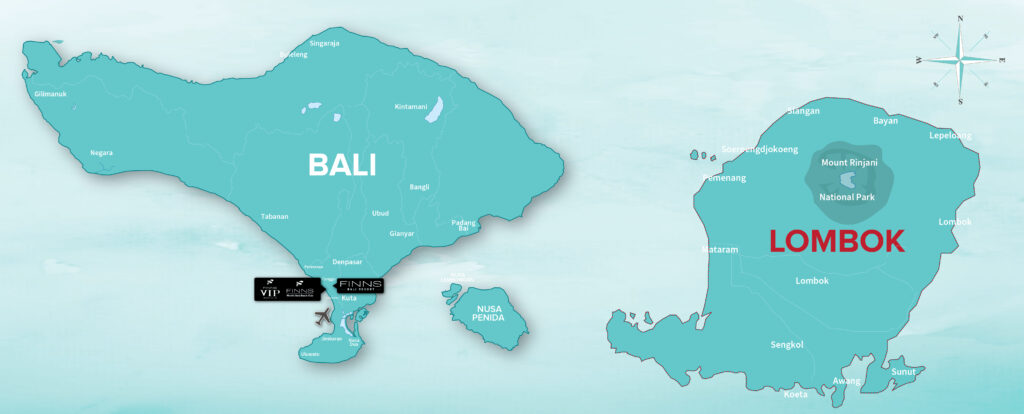
Just east of Bali, the next of the Lesser Sunda Islands, Lombok is a larger island with a more dramatic, untamed feel. Its landscape is defined by Mount Rinjani, an active volcano and Indonesia’s second-highest peak. Towering at over 3,700 metres, Rinjani dominates the skyline and shapes much of the island’s terrain with its ridges, caldera, and crater lake (Segara Anak).
The island features long stretches of untouched coastline, winding roads through forested hills, and fertile plains in the south where rice paddies flourish. The beaches here, especially in the south near Kuta Lombok, are known for their white, soft sand and turquoise waves, with fewer crowds than Bali.
Lombok’s geography feels wilder and more open, perfect for trekkers, surfers, and those craving off-the-beaten-path exploration.
Gili Islands
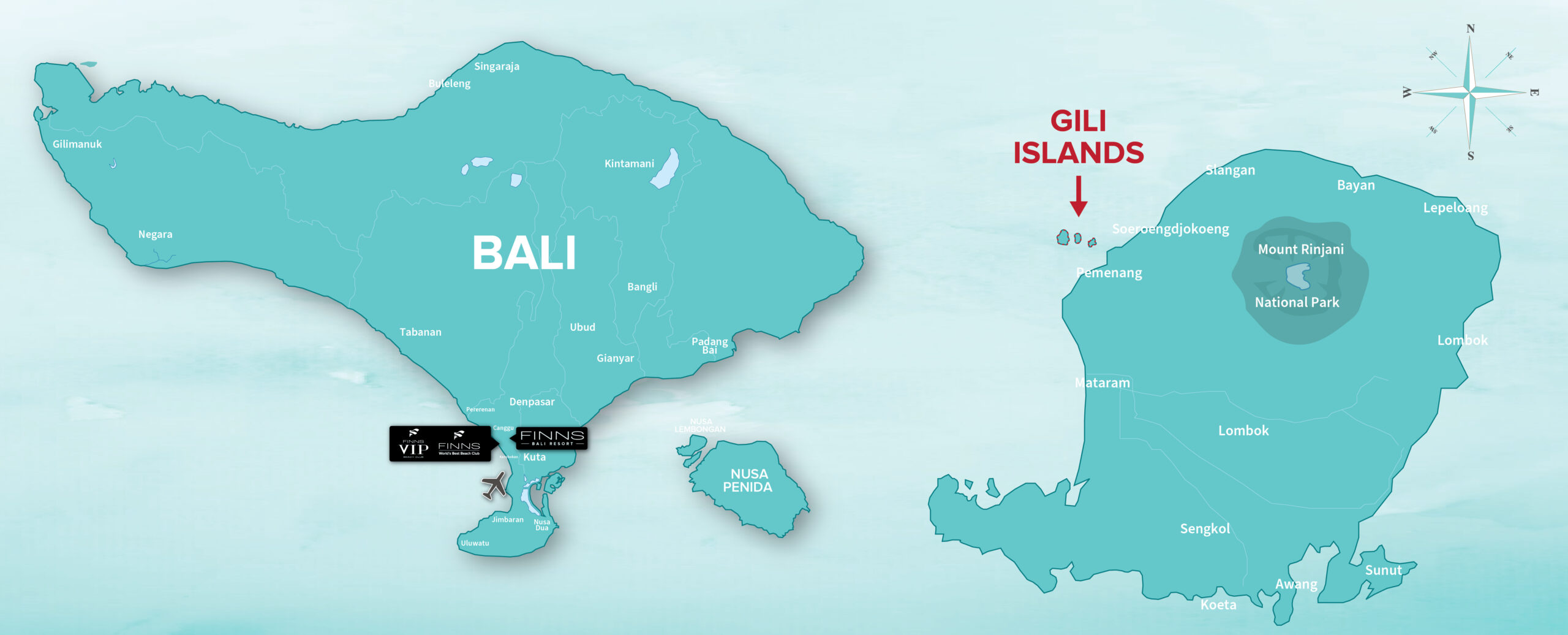
Just a stone’s throw off the northwest coast, in the Lombok Strait, lie the small but fascinating Gili Islands:
- Gili Trawangan
The westernmost of the small islands, Gili Trawangan, features powdery white beaches and calm, shallow waters perfect for snorkelling and diving. No motorised vehicles here—explore easily on foot or by bike. - Gili Meno
The smallest Gili, Meno, is nearly circular with narrow beaches and low scrubland. A saltwater lake at its centre attracts birdlife, adding to its quiet charm. - Gili Air
Closest to Lombok, Gili Air mixes coastal beauty with fertile inland coconut groves and farms. Its coral-lined shores offer views of Lombok’s mountains.
FAQs
Are There Tigers In Bali?
No, due to human intervention, the Bali Tiger became extinct during the 1950s and has not been seen on the island since.
What Is The Tallest Bali Peak?
The highest point in Bali is Mount Agung (Gunung Agung). Its elevation is 9,944 feet (3,031 meters) above sea level.
What Language Do They Speak In Bali?
The primary and official language spoken in Bali is Indonesian (Bahasa Indonesia), the national language of Indonesia.
However, many locals also speak the Balinese Language, which is the island’s traditional language used in daily life, ceremonies, and cultural rituals. English is common in tourist areas, but learning a few Balinese phrases can enrich your experience.
Final Thoughts On The Geography Of Bali
Bali may be small, but it’s packed with incredible diversity. From the volcanic peaks that shape its landscape to the lush highlands, vibrant coasts with rich marine life, and tranquil lakes, the island offers something for every kind of traveller.
Its unique location in the Indonesian archipelago means Bali blends natural beauty with rich culture and history. Whether you’re surfing the waves at Uluwatu, exploring sacred temples in Ubud, or relaxing at FINNS Beach Club on the west coast, understanding Bali’s geography adds depth to every experience.
It’s this mix of land, sea, and culture that makes Bali a truly unforgettable paradise.





